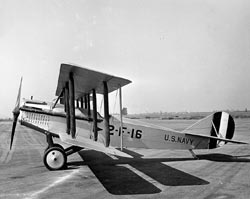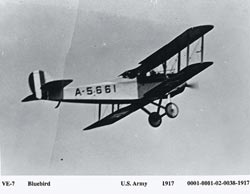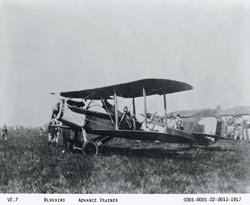|
 The VE-7 was a two-place, tractor biplane, advanced trainer. In response to a government request for an advanced training aircraft, Vought built a number of VE-7’s for test, the first being delivered on February 11, 1918. As a result, in May 1918, the Signal Corps ordered 14 VE-7 airplanes. The Navy eventually ordered 60, one of which was a VE-7SF, which made the first takeoff from America’s first aircraft carrier, USS Langley, on October 17, 1922. The VE-7 was a two-place, tractor biplane, advanced trainer. In response to a government request for an advanced training aircraft, Vought built a number of VE-7’s for test, the first being delivered on February 11, 1918. As a result, in May 1918, the Signal Corps ordered 14 VE-7 airplanes. The Navy eventually ordered 60, one of which was a VE-7SF, which made the first takeoff from America’s first aircraft carrier, USS Langley, on October 17, 1922.
After highly successful tests at Hazelhurst Field, the VE-7 was shipped, along with several duplicates, to the Airplane Engineering Department, McCook Field, Dayton, Ohio, for official flight and mechanical tests under the supervision of foreign and American aircraft officials, who were all unanimous in praise of the machine and its exceptional qualities.
Then in March of 1918, the airplane was extensively tested in open government competition with seven other makes. It was given the topmost recommendation that the VE-7 be procured immediately to replace several existing types then in rating by the official Test Board, with the additional use for training. The official report stated that “If the VE-7’s were to be used for all training (primary and advanced), a saving of time would result as the student would be capable of at once handling a service-type machine without having to be put through the stepping-up process, as is at present the case.”
 The VE-7 received high praise from many ranking and influential officers. Lt. Col. Virginius E. Clark declared the VE-7 as the finest training airplane yet produced and the only one designed as a sensible production machine. Brig. Gen. Billy Mitchell said “this Vought machine, a training type, has all of the air qualities of the single-seater and will out-maneuver the French Spad, Nieuport, and the English SE-5.” Officers of the English, French, and Italian Aviation Missions were equally unanimous in the choice. The VE-7 received high praise from many ranking and influential officers. Lt. Col. Virginius E. Clark declared the VE-7 as the finest training airplane yet produced and the only one designed as a sensible production machine. Brig. Gen. Billy Mitchell said “this Vought machine, a training type, has all of the air qualities of the single-seater and will out-maneuver the French Spad, Nieuport, and the English SE-5.” Officers of the English, French, and Italian Aviation Missions were equally unanimous in the choice.
The Bureau of Aircraft briefly considered building the VE-7 as a fighter. Two designs were promulgated: the VE-7A, a short-range fighter, and the VE-7B, a long-range version with a machine gun mounted on the fuselage behind the aft cockpit. However, the decision to stay with the already proven European fighters was locked in, and the VE-7 was developed purely as an advanced trainer.
 Common sense and simplicity were key terms used in describing the VE-7. It was the first airplane to be extensively flight tested and stress analyzed by the U.S. Army and proved to be the most uniform design sand-bag-tested up to that time. Reports commended it highly on mechanical, flight and maintenance features. Aside from its excellent performance, it was beautiful to behold, with a finish that rivaled the finest automobile and smart, blue trim, earning it the nickname, “Bluebird.” Common sense and simplicity were key terms used in describing the VE-7. It was the first airplane to be extensively flight tested and stress analyzed by the U.S. Army and proved to be the most uniform design sand-bag-tested up to that time. Reports commended it highly on mechanical, flight and maintenance features. Aside from its excellent performance, it was beautiful to behold, with a finish that rivaled the finest automobile and smart, blue trim, earning it the nickname, “Bluebird.”
The reports on the VE-7 represent the few surviving records of such tests conducted on an aircraft of the World War I era. They were prepared under the able direction of Lt. Alexander Klemin, USA. Professor Klemin established the fundamental criteria for stress analysis of aircraft which became the basis of procedure for all succeeding tests performed by the U.S. military services. The following excerpts from the VE-7 tests are of interest:
“No changes from the basic design are recommended, and the wing truss is perfectly satisfactory from a structural point of view.
“For flying qualities, this is the finest handling ship I ever flew.”
As a result of the flight tests and comparison with other manufacturers’ planes, the Army awarded Lewis & Vought the contract to build its VE-7 “Bluebird.”
VE-7:
The Aircraft that Got a Company Off the Ground
VE-7 Production
Additional Models
VE-7 as a History Maker
|